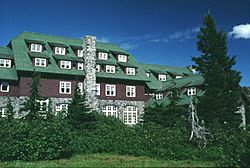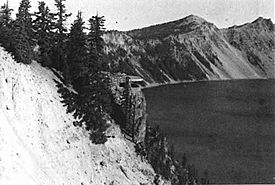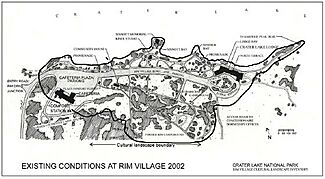Rim Village Historic District facts for kids
Quick facts for kids |
|
|
Rim Village Historic District
|
|

The Crater Lake Lodge in Rim Village.
|
|
| Location | Crater Lake National Park, Oregon |
|---|---|
| Nearest city | Fort Klamath, Oregon |
| Area | 38 acres (15 ha) |
| Built | 1909 |
| Architect | Charles Puchard, Jr., Thomas Vint |
| Architectural style | National Park Service rustic |
| MPS | Crater Lake National Park MRA |
| NRHP reference No. | 97001155 |
| Added to NRHP | September 18, 1997 |
Rim Village is a popular spot for visitors in Crater Lake National Park in southern Oregon. It sits right on the edge of the caldera (a big bowl-shaped hole left by a volcano) and looks out over Crater Lake. The National Park Service planned Rim Village so that all the important visitor services would be in one place. This makes it easy for people to reach trails and amazing viewpoints.
Because of its special "rustic" building style and the beautiful park scenery, Rim Village was listed as a historic district on the National Register of Historic Places in 1997.
The Story of Crater Lake
Crater Lake formed about 7,700 years ago. A huge volcano called Mount Mazama, which was about 12,000 feet (3,658 m) tall, collapsed after a massive volcanic eruption. Over thousands of years, rain filled the giant bowl left behind, creating the deep blue lake we see today.
The Klamath Native Americans deeply respected Crater Lake. In 1853, three gold miners found the lake and called it Deep Blue Lake. However, because the lake was so high up in the Cascade Mountains, people soon forgot about their discovery.
In 1886, Captain Clarence Dutton led a team from the United States Geological Survey. They carried a [convert: invalid number] survey boat, the Cleetwood, up the steep mountain. Then, they lowered it 2,000 feet (610 m) into the lake. From the Cleetwood, Dutton used piano wire to measure the lake's depth at 168 different spots. His team found the lake was 1,996 feet (608 m) deep. This was very close to modern measurements from 1959, which found the deepest point to be 1,932 feet (589 m).
William Gladstone Steel joined Dutton on his 1886 trip. He named many famous spots around the lake, like Wizard Island and Llao Rock. He also helped with lake surveys that showed how unique the lake was. After his trip, he started working to make Crater Lake a national park.
Becoming a National Park
On May 22, 1902, President Theodore Roosevelt signed a bill. This made Crater Lake the sixth national park in the United States. The United States Department of Interior was put in charge of building roads and visitor services. This was hard because the park was far away and high in the Cascade Mountains. By 1905, a "steep and winding" road to the crater rim was finished. This road was very important for building Rim Village.
In 1905, William Gladstone Steel brought photographer Frederick H. Kiser to Crater Lake. Many early photos of the park are Kiser's work. In 1907, Steel started the Crater Lake Company. This company ran "Camp Crater," which offered basic services to park visitors.
The Crater Lake Lodge was the first big building in what is now Rim Village. The Crater Lake Company started building it in 1909. The lodge was placed close to the rim so visitors could see the lake and the caldera. Because the location was so remote and the building season was short, the lodge wasn't finished until 1915.
The National Park Service was created in 1916. This was a big step for planning how national parks like Crater Lake would grow. The United States Congress also started giving money for park projects. However, when the United States entered World War I, park development slowed down.
After the war, the Army Corps of Engineers built several hiking trails from the lodge area. This allowed visitors to take day trips to Watchman Peak and Garfield Peak. They could then return to the lodge by evening. In 1921, Fred Kiser got permission to build a stone studio near the rim. Here, he sold his hand-colored photos of Crater Lake. By 1924, many things were available in the "Village" area. These included the lodge, a public campground, Kiser's studio, a park community center, and public restrooms.
Developing Rim Village
By 1927, visitors and park staff called the area around the lodge "Rim Village." The National Park Service approved a master plan for Rim Village's development in 1927. Congress also gave money to start this plan. Thomas C. Vint, who led the National Park Service's Landscape Engineering Division, oversaw the development.
Over the next 14 years, Crater Lake's buildings were built following this master plan. This is why buildings from this time have a similar "rustic" design. This style is common in National Parks.
Rim Village was built in two main stages.
- The first stage, from 1927 to 1932, included better roads, new rustic-style buildings, and a paved walking path along the rim. They also carefully planted trees and plants. During this time, they built small cabins, a general store, a cafeteria, and the Sinnott Memorial Observation Station. Park staff and hired workers did these improvements.
- The second stage, from 1933 to 1941, got help from the Civilian Conservation Corps (CCC). There were two CCC camps in the park with over 400 men. The CCC worked on building new facilities, improving landscapes, fixing roads, building new trails, and doing general park maintenance. Their work on the busy Rim Village campground was very important. For the first time, the campground had a clear layout for people and cars. Individual campsites were marked, and rustic picnic tables, benches, and fireplaces were built. This greatly reduced the impact of visitors on the campground's natural environment.
Building work at Rim Village stopped during World War II. Park staff focused on maintenance because the CCC workers left for the war. This started a period where Rim Village began to decline.
In 1955, the National Park Service started a new program to fix up park facilities across the country. The goal was to make park facilities similar everywhere. In Rim Village, some rustic features were changed or covered up to make things more modern. Original landscape elements were also changed or removed. Later, the Rim Village campground was completely removed. The area became a picnic spot for day visitors. The rustic tables and fireplaces were replaced with newer ones.
Even with these changes, the original design of Rim Village still stands out. The main buildings, general landscape, paths, and rim trails still match the first plan. Because of this, Rim Village was listed as a historic district on the National Register of Historic Places in 1997.
Main Buildings of Rim Village
There are six main buildings in the Rim Village Historic District. Five of them are original buildings. All six show the "rustic" style of architecture. This style is what makes Rim Village historically special.
Crater Lake Lodge
The Crater Lake Lodge is at the east end of Rim Village. A private company built it between 1909 and 1915. The lodge was made bigger in 1922. The National Park Service bought the lodge in 1967. It was completely rebuilt in 1991. The lodge was listed on the National Register of Historic Places in 1981.
Kiser Studio
The Kiser Studio was built in 1921. It was first a private studio where photographer Fred Kiser showed and sold park photos, paintings, and postcards. The National Park Service took over the building in 1929 to use as an exhibit hall. Today, it is the park's summer visitor center.
Sinnott Memorial Observation Station

The Sinnott Memorial Observation Station was built into the caldera cliff, looking over the lake. Landscape architect Merel S. Sager designed it. He was a pioneer of the rustic style for park buildings. The building has a small natural history museum. It shows exhibits about how Mount Mazama formed and how Crater Lake was created. The building was officially opened on July 16, 1931. It was named the Nicholas J. Sinnott Memorial Observation Station and Museum. The Sinnott Memorial was listed on the National Register of Historic Places in 1988.
Cafeteria and Gift Shop
The park's public Cafeteria and Gift Shop was built in 1928. The cafeteria was updated in 1956 and 1970. In 2007, the old cafeteria was torn down. A new, modern dining building was put in its place. It was designed in the rustic style to match the historic district.
Community House
The Community House was built in 1924. It was used for park programs until 1989. The National Park Service thought about tearing it down, but decided to fix it up instead. It went back to its original use in 2001.
Plaza Comfort Station
The Plaza Comfort Station (building 68) was built in 1938. It offered public showers, restrooms, and general services to park visitors. It is on the east side of the Rim Village plaza. The building is a one-story, wood-frame structure with heavy native stone on the outside. The Plaza Comfort Station was listed on the National Register of Historic Places in 1988 as Comfort Station No. 68.
There are also other smaller buildings in the Rim Village Historic District. One important smaller building is Comfort Station #4 (building 72). It is an original building from the early 1930s. This building was listed on the National Register of Historic Places in 1988 as Comfort Station No. 72. It is still an important part of Rim Village, even though it was changed a bit when it became an electrical transformer vault.
Roads and Paths
Today, the roads and paths in Rim Village still follow the original design. Rim Village has about half a mile of roads and several parking areas. The historic district also has over 1,450 feet (442 m) of stone walls and rustic stone viewpoints. These were built as part of the first Rim Village plan.
Paths are all over Rim Village. They help people walk to the rim viewing areas, buildings, and parking lots. The main walking paths are still the same as in the original Rim Village design. The most important path is the "Rim Promenade." It was built between 1928 and 1932. It follows the crater rim for about 2,500 feet (762 m). It goes from the Garfield Peak trailhead (east of Crater Lake Lodge) to the west end of Rim Village. Viewpoints along the Promenade offer amazing views of Crater Lake's blue water, Wizard Island, and the 1,000-foot (300 m) tall caldera walls around the lake. Other paths lead to the Crater Lake Lodge, Sinnott Memorial, Rim Village Plaza, and parking areas.
Visiting Rim Village
Rim Village is in the Cascade Mountains, 7,100 feet (2,164 m) above sea level. In the Rim Village area, winter lasts eight months. It gets an average of 533 inches (13.5 m) of snow each year, and many snow banks stay well into the summer.
You can usually visit Rim Village all year round. However, the cafeteria and gift shop are the only places open in winter. During the winter months, park rangers lead snowshoe walks on weekends and holidays. In the summer, rangers offer daily programs. These programs teach about how Mount Mazama formed, how Crater Lake was created, the lake's unique natural features, why its water is so blue, and the park's history.




